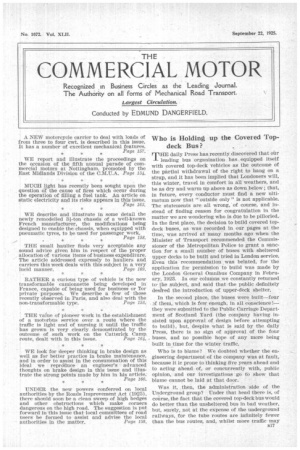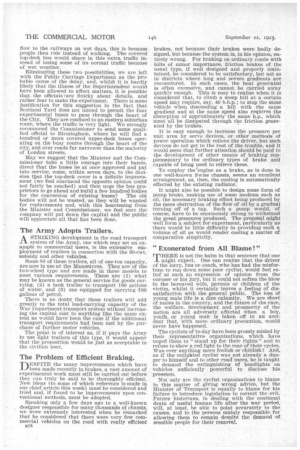Who is Holding up the Covered Topdeck Bus ?
Page 1

Page 2

If you've noticed an error in this article please click here to report it so we can fix it.
rpHE daily Press has recently discovered that ottr leading bus organization has equipped itself with covered top-deck vehicles as the outcome of the partial withdrawal of the right to hang on a strap, and it has been implied that Londoners will, this winter, travel in comfort in all weathers, and be as dry and warm up above as down below ; that, in future, every conductor must find a new ultimatum now that 'outside only" is not applicable. The statements are all wrong, of course, and instead of finding reason for congratulation in the matter we are wondering who is due to be pilloried. In the first place, the decision to build covered topdeck buses, as was recorded in our pages at the time, was arrived at many months ago when the Minister of Transport recommended the Commissioner of the Metropolitan Police to grant a sanction for a small number of buses with sheltered upper decks to be built and tried in London service. Even this recommendation was belated, for the application for permission to build was made by the London General Omnibus Company in February, 1923. In our coluMns we constantly returned to the subject, and said that -the public definitely desfred the introduction of upper-deck shelter.
In the second place, the buses were built—four • 3f them, which is few enough, in all conscience :— they were submitted to the Public Carriage Department of Scotland Yard (the company having insisted upon approval of design before attempting to build), but, despite what is said by the daily. Press, there is no sign of approval of the four buses, and no possible hope of any more being built in time for the winter traffic.
Who is to blame? We doubted whether the engineering department of the company was at fault, because it in prone to thinking live years ahead and to acting ahead of, or concurrently with, public opinion, and our investigations • go to show that blame cannot be laid at that door.
Was it, then, the administration side of the Underground group? Under that head there is, of course, the fact that the covered top-deck bus would do better than the unsheltered bus in bad weather, but, surely, not at the expense of the underground railways, for the tube routes are infinitely fewer than the bus routes, and, whilst More traffic -may flow to the railways on wet days, this is because people then ride instead of walking. The covered top-deck bus would share in this extra traffic instead of losing some of its normal traffic because of wet weather.
Eliminating these two possibilities, we are left with the Public Carriage Department as the probable cause of the delay, and, whilst it is hardly likely that the illness of the Superintendent would have been allowed to affect matters, it is possible that the officials tare finicky about details, and rather fear to make the experiment. There is some justification for this suggestion in the fact that Scotland Yard does not intend to permit the four experimental buses to pass through the heart of the City. They are confined to an eastern suburban route, where the traffic is very light. We strongly recommend the Commissioner to send some qualified official to Birmingham, where he will find a hundred or more covered upper-deck buses operating on the busy routes through the heart of the city, and over roads far narrower than the majority of London streets.
May we suggest that the Minister and the Commissioner -take a little courage into their hands, direct itiat the buses be at once approved and put into service, come, within seven days, to the decision that the top-deck cover is a definite improvement (we feel convinced the opposite opinion could not fairly be reached) and then urge the bus proprietors to go ahead and build a few hundred bodies for the conversion of existing buses? The old bodies will not be wasted, as they will be wanted for replacements and, with this heartening from the Minister and Commissioner, we feel sure the company will put down the capital and the public will appreciate all that has been done.
The Army Adopts Trailers.
A STRIKING development in the road transport 1-1 system of the Army, one which may set an example to commercial users, is the extensive employment of trailers in connection with the 30-cwt. subsidy and other vehicles. Some P-.-2.0 of these trailers, all of one-ton capacity, are now in use at the Manoeuvres. They are Of the two-wheel type and are made in three models to meet various requirements. These are (I) what may be known as the general service for goods carrying, (2) a tank trailer to transport 180 gallons of water, and (3) one equipped for carrying 180 gallons of petrol. There is no doubt that these trailers will add greatly to the total load-carrying capacity of the War Department transport system without increasing the capital cost to anything like the same extent as would have been the case if the additional transport requirements had been met by the purchase of further motor vehicles. The point is of interest as, if it pays the Army to use light trailers of this type, it would appear that the proposition would be just as acceptable to the civilian user.
The Problem of Efficient Braking.
TNESPITE the -many improvements which have been made recently in brakes, a vast amount of experimental work must still be carried out before they can truly be said to be thoroughly efficient. New ideas (to some of which reference is made in our chief article this week) must be considered and tried and, if found to be improvements upon conventional methods, must be adopted. Speaking only a few days ago to a well-known designer responsible for manythousands of chassis; we were extremely interested when he remarked that he considered that there were very few commercial vehicles on the road with really efficient n18 brakes, not because their brakes were badly designed, but because the system is, in his opinion, en tirely wrong. For braking on ordinary roads with hilts of minor importance, friction brakes of the usual type, if well designed and properly main tained, he considered to be satisfactory, but not so in districts where long and severe gradients are encountered. In such eases, the heat generated is often excessive, and cannot be carried away quickly enough. This is easy to realize when it is considered that, to climb a steep hill at a certain speed may require, say, 40 b.h.p. ; to stop the same vehicle when descending a hill with the same gradient and at the same speed also requires the absorption of approximately the same h.p., which must all be dissipated through the friction generated by the brakes.
It is easy enough to increase the pressure per unit area by servo devices, or other methods of power operation which relieve the driver, but such devices do not get to the root of the trouble, and it would seem that further attention should be paid to the development of other means of braking supplementary to the ordinary types of brake and capable of being used to relieve these.
To employ the'engine as a brake, as is done in one well-known Swiss chassis, seems an excellent arrangement, as, then, the cooling is automatically effected by the existing radiator.
It might also be possible to design some form of pump brake, making use of some medium such as oil, the necessary braking effect being produced by the mere obstruction of the flow of oil by a gradual turning off of a tap. Such a pump would, of course, have to be enormously strong to withstand the great pressures produced. The proposal might well form a subject for experiment, particularly as there would be little difficulty in providing such a volume of oil as would render cooling a matter of comparative simplicity.
"Exonerated from All Blame!"
gruiERE is not the balm in that sentence that one 1 might expect. One can realize that the driver of the lorry, bus or coach, who has had the misfortune to run down some poor cyclist, would feel relief at such an expression of opinion from the coroner or his jury. but it could not soften the blow to the bereaved wife, parents or children of the victim, whilst it certainly leaves a feeling of dissatisfaction with the general public. The loss of young male life is a dire calamity. We are short of males in the country, and the future of the race, the welfare, development and prosperity of the nation are all adversely affected when a boy, youth, or young matt is taken off in an accident that, with mere ordinary precaution, would never have happened. The cyclists of to-day have been grossly misled by their representative organizations, which have urged them to "stanch up for their rights " and to refuse to show a red light to the rear of their cycles. Was ever anything more foolish or childish? And, as if the unlighted cyclist was not already a danger to himself and to other road'users, he is taught to demand the extinguishing of headlights on vehicles sufficiently powerful to disclose his presence. Not only are the cyclist organizations to blame in this matter of giving wrong advice, but the Minister of Transport is equally to blame for his failure to introduce legislation to correct the evil. Future historians, in dealing with the continual drain of useful human life after the war period, will, at least, be able to point accurately to the causes, and to the persons mainly responsible for allowing them to remain despite the demand -of sensible people for their removal.




























